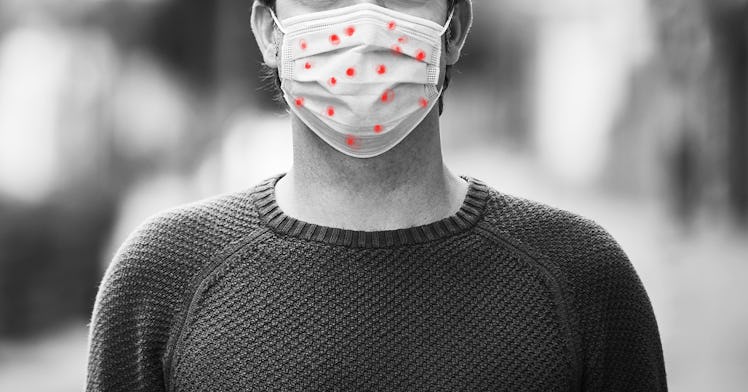Is Your Mask Causing Acne? Here’s How to Treat It
Is your face broken out or simply irritated from wearing a mask? Here's how to keep your skin in good shape.

Wearing a mask, along with social distancing, is our best defense against Covid-19. But strapping a piece of cloth to our faces isn’t exactly ideal for our skin and can to cause irritations and breakouts. Known colloquially as “maskne”, mask-acne is nothing more than a minor annoyance that comes as a result of doing our job to flatten the curve. But if you’re concerned about your face mask causing acne, there are some simple steps to follow to keep your skin under control.
According to double-board certified dermatologist Dr. Brendan Camp, “maskne” is actually called something much cooler: acne mechanica. “With this condition,” he says, “frictional forces from the mask cause pores to clog, which leads to the formation of acne, and the masks create a warm, moist environment suitable for the growth of bacteria.”
This certainly makes a lot of sense. So does the treatment: good hygiene. According to Dr. Camp, acne mechanica can be managed through grooming, skincare, diet, and a healthy daily routine — all things that you should be adhering to regardless of face mask usage or not. So, if you’re concerned about your mask causing acne, here’s what to know.
1. Cleanse (Pre-Mask)
Just like stretching to prevent injury before working out, your face will thank you for a little pre-mask attention. “It’s important to wash your face before putting on a mask,” says Dr. Camp. “A gentle cleanser such as Cetaphil or CeraVe is usually sufficient, but those with more severe acne should consider cleansers with salicylic acid, which is able to penetrate pores more deeply and flush out buildup.” In addition, Dr. Camp recommends applying a toner (like this one), which will help tighten, unblock ,and minimize pores to reduce the potential for breakouts.
2. Moisturize (Pre-Mask)
Cultivating a routine that includes consistent moisturizing is key to keeping your skin soothed throughout the day. “Use a daily moisturizer with SPF,” advises Dr. Camp. “Even though your mask is covering part of your face, the SPF will protect your bare skin from incidental sun exposure.” Even though some may claim that the sun “dries out” their skin, making it less oily and irritable, prolonged exposure can interfere with the normal process of shedding dead skin cells, which can further clog up your pores.
3. Wash. Your Mask.
Using a disposable mask? Fine. But reusable cloth masks need to be washed after each usage. In addition to virus prevention, washing a mask helps eliminate the crowds of bacteria that irritate your skin and lead to more breakouts. (This is also why you should wash your pillow cases regularly, too). The CDC even recommends soaking your mask(s) in a homebrewed bleach solution (4 tsp of bleach per quart of room temperature water) as an extra safeguard. But giving them a run through the washing machine is also okay
4. Watch Your Diet.
Good hygiene 101: What you consume has a lot of effect on the appearance of your skin. This is all the more pertinent to understand when your face is covered by a sweaty mask. A refresher: Dr. Camp advises drinking a lot of water and sticking to a high-nutrient, low sugar diet. “A diet that causes a spike in blood sugar — a diet with a high glycemic index — may contribute to acne by triggering a hormonal cascade that leads to its formation of acne,” he says. “Drinking plenty of water will also help with acne prevention, because the skin will be more hydrated and able to flush out toxins more effectively.”
5. Don’t Forget a Second Cleanse
In addition to washing your face after taking off your mask, a good nightly skincare routine is crucial to killing that bad bacteria. Dr recommends any over-the-counter products that contain benzoyl peroxide, salicylic acid, or adapalene (everyone’s skin is different, so choose a product that’s right for you). Use a cleaner that has anti-bacterial properties as well as something with vitamin A that helps regulate cell turnover and prevent further pore blockage.
6. Moisturize Again
Moisturizing at night is as important as moisturizing during the day.. “After treatment, it is important seal in the skin’s moisture,” explains Dr. Camp. “You must maintain the health of the skin barrier, and repair any damage from the day.” Dr. Camp adds that a moisturizer is also important to treat dry skin that can develop as a result of wearing a mask made of material that absorbs the skin’s natural oil throughout the day.
Bonus: Grow a Beard (If You Want)
A little bit of facial hair can actually help your skin survive being trapped by a mask. Leaving a little stubble may help prevent ingrown hairs, which can develop if the hair is too closely shaven and then rubbed repeatedly by the mask. The number one job of a mask is to filter air properly so, as long as your beard isn’t prohibiting it from doing so, it can always be the perfect time for a five o’clock shadow. The CDC has published an infographic of facial hair styles that are most suitable for masks that require tight fits, such as the N95. So give it a read before you beard up.
This article was originally published on